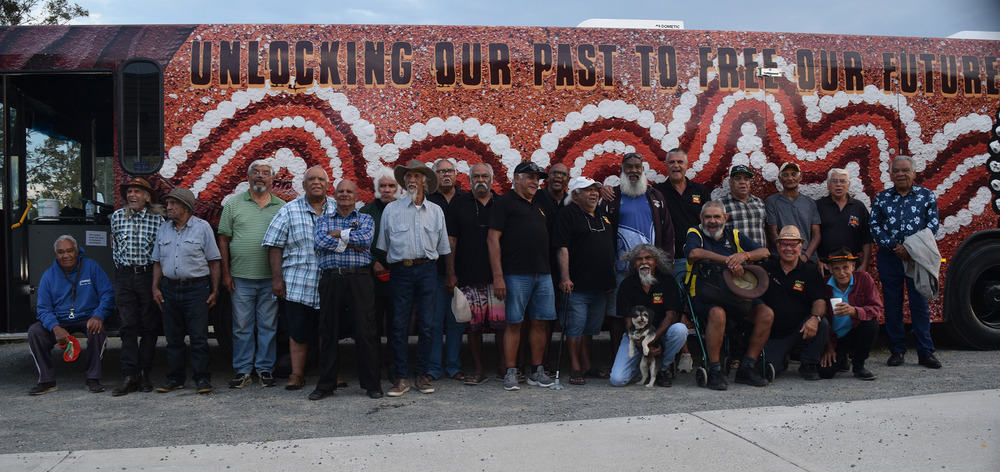In 2002, a group of Kinchela Boys Home survivors returned to the site of the home in Kempsey NSW for the first time since they were boys.

With strong childhood bonds never broken, the men were on a journey to reconnect with each other, reclaim their past and support survivors and their families to heal.
Kinchela Aboriginal Boys Training Home was run by the NSW Government from 1924 – 1970 to house Aboriginal boys forcibly removed from their families in order to assimilate them into white Australian society. Built on the stolen land of the Dunghutti, it holds memories, painful and otherwise, for Survivors, and it is a place of deep importance for them, their families, and communities.
The return was not an easy process, as survivors had to confront their experiences – which many had buried. The deep bonds they formed as boys helped them to endure the abuse and harsh conditions of the boys’ home, where they were assigned numbers instead of names.
‘Some of the Uncles said we need an organisation that’s ours, that looks after the brothers and looks after our families,’ Tiffany McComsey, CEO of the Kinchela Boys Home Aboriginal Corporation (KBHAC) said.
‘And from that journey this organisation started, and the hope that truth-telling would really lead to change.’
Kinchela’s mission
Over time, KBHAC have developed a survivor-led model of governance and healing. Survivors own their stories and tell them from a place of self-determination.
‘We know how to develop the programs that we need to be able to help the rest of the families and brothers feel in a safer place,’ said KBHAC Chair Uncle Michael Welsh.
KBHAC members emphasise the power of truth-telling to prevent a repetition of the abuse they endured and to create social change.
‘Talking is never easy because it brings back memories that I shut out for so many years but if we don’t keep doing this it allows this trauma to grow. That’s the strength that I gain from this and the journey of the KBH brothers,’ said Uncle Michael.
Truth-telling on the move
In 2020, KBHAC launched a mobile education centre, or ‘site of conscience’. Set up in an old commuter bus, it is an immersive experience designed to convey hard truths about the Kinchela Boys Home.
The front half of the bus is an exhibition that was developed in consultation with the survivors. The back is a cinema and yarning space, where a short, animated film produced by survivors is shown.
The immersive experience helps people to viscerally understand in a way that reading a report does not.
‘We’ve had ministers who have been told multiple times and then all of a sudden, they’re like, “Wait, you were numbers? You didn’t have names?”‘ Tiffany said.
The mobile education centre also has a recording booth where visitors can share their reflections, community members can record their stories about KBH, and the Stolen Generations, and related community histories can be documented. These truths become an educational resource and record for future generations.
Tiffany explained that sharing these experiences between descendants of survivors allows for the sense of isolation to be broken down: ‘It’s like this light bulb goes on and it’s like, it wasn’t just my family.’
Driving engagement
The mobile education centre facilitates a safe space for meaningful engagement. It’s a survivor-led opportunity to extend stories beyond the act of personally retelling their trauma and encouraging two-way interactions.
KBHAC wants the mobile education bus to connect with the hearts and minds of future generations, which is why its content and media target a young audience. The yarning circle space brings in oral testimony, archival material, artifacts, film, images, audio and interactive materials.
The future of Kinchela
Uncle Michael and Tiffany emphasise that truth-telling is an ongoing process – institutional change is slow and intergenerational trauma cannot be addressed in a one-off event.
While the mobile education centre delivers truth-telling all over the country, the Kinchela Boys Home site has become a permanent place of truth-telling grounded in the power of tangible evidence.
The KBHAC has been campaigning to obtain ownership over the land so it can be turned into a national site of truth-telling and healing with the creation of a living museum and healing centre.
The site was added to the 2022 World Monuments Fund Watch List as one of 25 heritage sites of worldwide significance.
Creating a permanent site of truth-telling allows survivors and communities to reclaim their past by determining the future of the place that impacted them so deeply.
‘My love in my heart, as a kid, is still in that bloody home. It’s a fact and returning the ownership to KBH survivors is going to allow me to return the love that I lost in that place,’ said former resident Roger Jarrett.
‘Just the thought of going there makes you feel a little bit better than you were before, giving you a feeling that you achieved something. I achieved my last little bit of pain easing, you know.’
This account of truth-telling in action is based on a case study from the Recognising community truth-telling: An exploration of local truth-telling in Australia report. The collaborative study between Reconciliation Australia and Deakin University’s Alfred Deakin Institute for Citizenship and Globalisation documents 25 community truth-telling projects.
See more of Deakin University’s Alfred Deakin Institute for Citizenship and Globalisation’s research via deakin.edu.au/adi
This article is from Reconciliation News #52. Read the rest of the issue.



